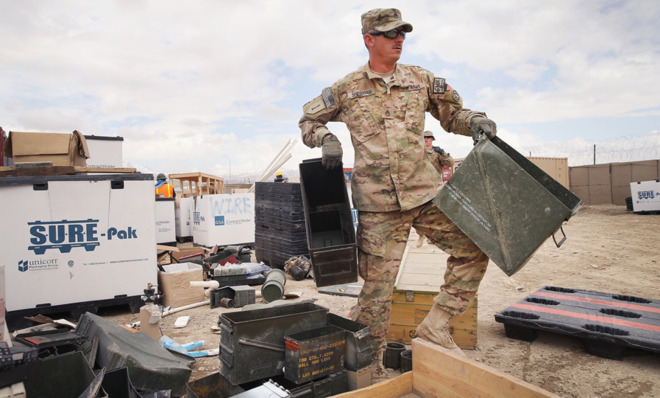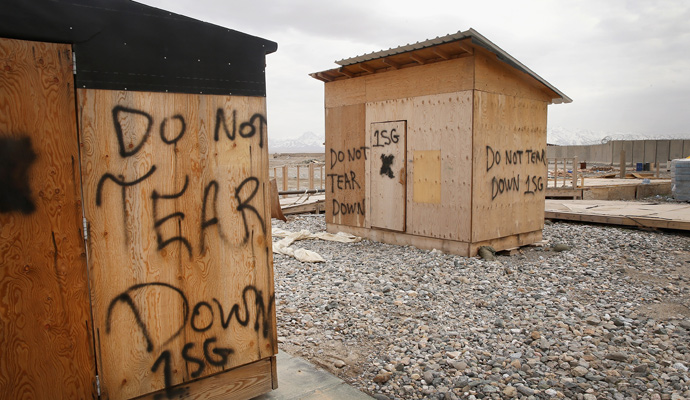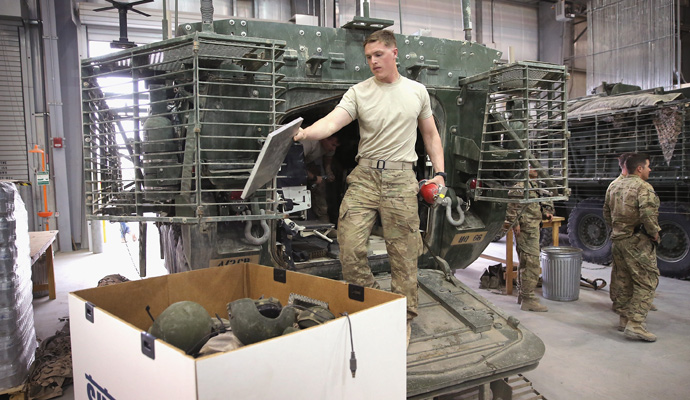The crazy logistics of packing up the U.S. war in Afghanistan
"For size and complexity, think of something in between D-Day and the moon landing."


As Afghans prepare for a runoff to the April 5 presidential election, another historic transition is taking place — the full withdrawal of international coalition forces from the country by Dec. 31, 2014.
That's when NATO's combat mission expires, ending 13 years of foreign military presence in Afghanistan, which began when U.S.-led troops ousted the Taliban in 2001.
By joint agreement, the NATO-led International Security Assistance Force (ISAF) and the U.S.-led Operation Enduring Freedom (OEF) are disengaging from combat activities and handing over security to Afghan forces.
The Week
Escape your echo chamber. Get the facts behind the news, plus analysis from multiple perspectives.

Sign up for The Week's Free Newsletters
From our morning news briefing to a weekly Good News Newsletter, get the best of The Week delivered directly to your inbox.
From our morning news briefing to a weekly Good News Newsletter, get the best of The Week delivered directly to your inbox.
They're also shipping home over a decade's accumulation of personnel and equipment. The logistical pull-out — known as a "retrograde" in military terms — is nearly unprecedented in scope. Foreign Policy explains:
"...in raw tonnage, it's the biggest single military logistical undertaking ever. For size and complexity, think of something in between D-Day and the moon landing." [Foreign Policy]
Here's a look at what's involved in sending (nearly) everything and everyone home from Afghanistan.
THE PROCESS
1. Tens of thousands of combat troops must be sent home.
A free daily email with the biggest news stories of the day – and the best features from TheWeek.com
There are now 51,100 ISAF troops from 48 contributing countries — a huge drop from peak levels in 2011 of 140,000 troops. Today the top five contributors are the United States (33,500), the United Kingdom (5,200), Germany (2,730), Italy (2,019), Jordan (1,066), and Romania (1,021). "The challenge they have now is backward planning so that they are able to retrieve, clean, repair, and redeploy all the gear they can — and then redeploy themselves,"reports Stars and Stripes.
2. Coalition bases must be closed and transferred to Afghan forces.
For the last two years, coalition forces have been closing forward operating bases and combat outposts and handing them over to the Afghan National Security Forces. The number of bases and outposts has dropped from 850 to 90. The goal is to get down to 10 to 12 bases by the end of the year, said former ISAF commander General John Allen. Personnel are also "descoping" the bases — emptying them of vehicles, weapons, equipment, and other supplies, which are sent to one of several cargo yards for inventory, assessment, and processing. Anything deemed "mission essential" is prepared for redistribution to active units. Everything else is transported home, transferred to Afghan forces, sold to "nearby friendly nations," or scrapped locally.
3. Billions of dollars of vehicles and equipment must be shipped out.
Each coalition country is responsible for withdrawing its own equipment. Last year, the United States had an estimated $36 billion worth of gear in Afghanistan — which would cost $6 billion just to process. As of this March, it was down to around $15 billion. The "keepers" ($10 billion) are mostly "high-dollar value items" (e.g., helicopters, vehicles) and anything that can be reused by the military.
They also include "sensitive and lethal" equipment (e.g. weapons, optical devices, advanced communications, and intelligence systems) — items that could be attractive to insurgent or criminal organizations. Preventing equipment diversion is a concern. Military expert Lawrence Korb told Fox News: "If you give that stuff to the Afghan or even the Afghan security forces, it could still end up with the Taliban. You have to err on the side of caution." Items are repaired, dismantled, and placed in containers for transport.
4. Anything left over must be transferred, sold, or scrapped.
What about the unwanted gear — the items excess to requirements, too damaged or too expensive to move? "Non-military equipment, such as cubicles, desks, lockers, generators, computers, and televisions, are left to Afghan forces that take over the base — if they want them," reported the BBC. "If they don't, they are removed and disposed of."

WITHDRAWAL ROUTES
1. Afghanistan's rugged terrain makes it a "mover's nightmare."
There are several routes for material to exit the country — by air, land, sea, or a combination of these methods. But Afghanistan is a landlocked, mountainous country with difficult weather, poor roads, and even worse communication links. This creates a "'nightmarish' geography for logistical planners" and limits the available transit options. As NATO's Civil-Military Fusion Centre (CFC) notes, "It does not have access to the sea or nearby ports, from which cargoes and containers can be easily shipped abroad... The lack of deep-water ports leaves ISAF at the mercy of neighboring countries to transport supplies or complete draw-down operations…."
2. Cargo can go south through Pakistan.
Trucks move some equipment south to the Karachi seaport in Pakistan, a corridor known as the Pakistan Ground Lines of Communication, or PAKGLOC. From there it's transported via sea to its final destination. In 2011, Pakistan closed the route for seven months in retaliation for a NATO airstrike that killed 24 Pakistani soldiers. The border has since been reopened and the United States sends around 42 percent of its cargo through the PAKGLOC. While it's the most economical route, the backlog — combined with the risk of disruptions — have caused coalition forces to seek out alternate options.
3. Cargo can go north through Central Asia and Russia.
Equipment is also flowing through the Northern Distribution Network (NDN) — a 5,000-km network of road, rail, and sea routes through Kyrgyzstan, Kazakhstan, Tajikistan, Uzbekistan, Turkmenistan, and Russia. Around 3 percent of U.S. equipment leaves this way. But sending cargo via the NDN requires a complex set of agreements, compensations, and conditions, including economic, political, and military concessions to the Central Asian countries. Additionally, since many restrict the type of equipment that can enter or be visible, all cargo must be placed in containers. Major end items are dismantled and stripped to deter theft and shipped via ground, but sensitive, classified, or lethal equipment is flown out instead.
4. Cargo can be airlifted home — at tremendous expense.
Some equipment is flown to regional ports (and then shipped by sea), or flown directly to the country of origin. It's the fastest and safest option, but also the most expensive, costing 10 times more than ground or sea transport, per pound. Therefore it's reserved for the heaviest or most high-value equipment. These items are loaded onto cargo planes, then — in the case of the U.S. — flown "to the Indian Ocean atoll of Diego Garcia and then directly into Fort Blair and other air bases in the continental United States," notes Foreign Policy.

COMPLICATIONS
Here are some of the problems coalition countries face at each step of the withdrawal process.
1. The withdrawal timeline is both aggressive and uncertain.
Some international troops are expected to remain after December 2014 to mentor Afghan forces and to conduct counter-terrorism operations. But the exact number, if any, depends on the U.S. and Afghan governments finalizing a Bilateral Security Agreement. Otherwise the U.S. and NATO will withdraw all forces, not just combat troops — the so-called "zero option." The U.S. has estimated it needs 102 days to conduct an orderly withdrawal — meaning a decision must be made by September. In the event of the zero option, military logisticians are preparing "to expedite operations if so ordered," reports Army News Service.
2. Coalition forces are handling multiple missions — in a hostile environment.
"In the Afghanistan context, coalition troops face a particular and difficult challenge," notes NATO's CFC. They're busy organizing a massive logistical pull-out — taking home equipment and people, eliminating hazardous materials, taking care of unexploded ordnance, and transferring bases to Afghan forces, General Joseph F. Dunford Jr. noted in March. At the same time, they're providing security support during the elections and political transition, providing operational assistance, and training to the Afghan National Security Forces, and sustaining combat operations against the Taliban — all in the midst of an ongoing war.
3. There's significant red tape inside and outside Afghanistan.
"In addition to security concerns, U.S. transportation officials have had to contend with a burdensome Afghan bureaucracy that keeps imposing new fees and restrictions on shipments," reports National Defense Magazine. As the Afghan government has become more capable, it's imposed clearance requirements and customs duties to generate revenue — adding delays and costs to the withdrawal. There's also the matter of obtaining clearance to transport cargo through the various PAKGLOC and NDN countries, which requires approval from officials in both transit and home countries. Any problems in the paperwork can hold up cargo, and delays in cargo transit can seriously throw off shipment schedules.
4. Meanwhile, there are complex military-political dynamics in the region.
First, there's the matter of the security situation in neighboring countries. Along the Pakistan withdrawal route, "Afghan and Pakistani insurgent elements continue to carry out attacks on international convoys," reports CFC. "The availability of the PAKGLOC to the coalition will also depend upon health of Afghan-Pakistani bilateral relations," it adds. Then, there are the larger regional dynamics relating to the Northern Distribution Network. Should Russia restrict U.S. access over its territory given current tensions over Ukraine, Washington would need to pursue other options for withdrawing cargo from Afghanistan.
This article, by Sarah Dougherty, originally appeared at GlobalPost.
More from GlobalPost...
-
 Political cartoons for December 7
Political cartoons for December 7Cartoons Sunday’s political cartoons include the Trump-tanic, AI Santa, and the search for a moderate Republican
-
 Trump’s poll collapse: can he stop the slide?
Trump’s poll collapse: can he stop the slide?Talking Point President who promised to ease cost-of-living has found that US economic woes can’t be solved ‘via executive fiat’
-
 Codeword: December 7, 2025
Codeword: December 7, 2025The daily codeword puzzle from The Week